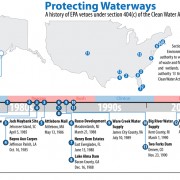More Evidence of Nitrate Cancer Risk in Drinking Water
Case builds of health damage from a common pollutant.

Sunrise casts a glow over Illinois farmland. States in the Midwest have some of the highest nitrate concentrations in groundwater because of farm fertilizers and manure. Photo © J. Carl Ganter / Circle of Blue
By Brett Walton, Circle of Blue
The U.S. drinking water standard for nitrate was set decades ago at a level to prevent infant deaths. But recent research suggests that the standard, decided in 1991, is out of date.
Scientists are accumulating evidence that the U.S. Environmental Protection Agency’s nitrate limit may need to be lowered because it does not account for potential long-term health damage, including the risk of cancer, that harms people into their adult years.
A perennial environmental menace — as a trigger for the annual Gulf of Mexico dead zone and the degradation of Long Island’s estuaries — nitrate pollution in groundwater and rivers is growing worse, especially in farm regions, where crop fertilizer and manure are primary sources of the chemical. Cleaning up the mess is causing municipal budgets to balloon.
A study published in May by the Northeast-Midwest Institute, a public policy group, found that removing nitrate has raised the cost of water treatment in the last decade. Des Moines Water Works, which serves Iowa’s capital city, spent 9 percent of its operating budget in 2015 on nitrate removal, a year in which concentrations in its source water spiked. Building a treatment facility can cost a mid-sized city $10 million to $15 million.
Even as farmers and lawmakers struggle to stanch the flow of the plant nutrient into waterbodies, studies in the United States and Denmark suggest that they ought to do more in order to protect public health. The research calls into question the current EPA nitrate standard of 10 parts per million, and indicates a higher risk of bladder, ovarian, and colorectal cancer from nitrate levels half the legal limit. The EPA, for its part, has initiated its own health assessment of nitrate, the results of which will inform any agency attempt to strengthen the drinking water standard.
Though the studies are peer reviewed and comprehensive, using decades of data on nitrate exposure and cancer outcomes for thousands of people, researchers caution that more assessments will be needed before they can make definitive claims about the health risk at lower levels of nitrate in drinking water. There is an association between some cancers and nitrate consumption below the federal standard, but additional studies need to be done to determine how consistent those associations are and what the risk level is, they say.
“We really need to do more studies,” Mary Ward of the National Cancer Institute told Circle of Blue. “One study is usually never definitive in epidemiology.”
The nitrate problem has built up over decades. Though nitrate occurs naturally in soils and can even be deposited into lakes from the air, the steady rise in concentrations in the nation’s waterways and aquifers is a manmade phenomenon. Septic tanks, lawn fertilizer, and wastewater treatment facilities are contributors. But the largest share comes from plant vitamins that are sprinkled on farm fields and not taken up by the crop. Not all of the excess is immediately absorbed by rivers and aquifers. A large portion is lodged in the soil, where it moves slowly downward. Researchers in the United Kingdom call this massive buildup of nitrate in unsaturated rock and soil layers just above the groundwater table a global problem that will take decades to unspool.
The EPA is also taking a closer look at nitrate. The Integrated Risk Information System, or IRIS, is the agency office that provides the scientific foundation for quantifying the health risks of chemicals in water, soil, and air.
IRIS announced last September that it will reassess nitrate and nitrite, a related nitrogen compound, largely because the EPA Office of Water expressed interest in an updated appraisal. In its most recent review of national drinking water regulations, the Office of Water determined in December 2016 that the nitrate standard did not warrant a revision.
The IRIS assessment, which will look at effects on cancer, fetal development, blood cells, thyroid, type 1 diabetes, and the reproductive system, will inform the agency’s next move. The EPA’s plan is to have a draft available for public comment in 2020 and a finalized peer reviewed draft by late 2021.
The strongest move would be to lower the nitrate standard, but that will not happen quickly, regardless of the Trump administration’s scorn for limits against water pollution. The regulatory process is not designed for speed, Joseph Cotruvo, a former director of the EPA drinking water standards division, told Circle of Blue. The EPA, for instance, is still developing a standard for perchlorate, a drinking water pollutant the agency said, in February 2011, that it would regulate.
For nitrate, the EPA could choose to take the IRIS assessment into consideration during the next comprehensive review of drinking water regulations, which is expected to occur in 2021-22. But it does not have to wait, Cotruvo said. The agency can determine at any point that the science is strong enough to warrant an update.
Because it is a Safe Drinking Water Act regulation, the consequences of a lower nitrate limit would fall primarily on water utilities and their customers. Like Des Moines, some would have to install nitrate-removing equipment. Areas of the country with the highest nitrate concentrations in surface and groundwater include the agricultural states of the Midwest and Great Plains, California’s Central Valley, the Yakima Valley of Washington state, and the Delmarva peninsula.
“Once the assessment is completed, EPA will determine the next appropriate steps,” Enesta Jones, an agency spokeswoman, told Circle of Blue.
Assessing the Nitrate Risks
Ward, an environmental epidemiologist, is one of the country’s leading experts on the cancer consequences of nitrate in drinking water, having studied the connections for two decades. Her research draws on health and environmental data that extend over generations.
One of those data sets is the Iowa Women’s Health Study, which has followed the health outcomes of a group of almost 16,000 Iowa women since the late 1980s. Another is the Agricultural Health Study, a cohort of 92,000 farmers and spouses in Iowa and North Carolina. Iowa is a particular interest for nitrate researchers because of intensive farming there — 80 percent of the state is cropland or pasture.
Ward and colleagues are still analyzing data from the Agricultural Health Study, but they have published papers that look at nitrate in drinking water and the risk of various cancers based on the Women’s Health Study and other data from Midwest states. They consistently found no association with pancreatic cancer, but found hints of an increased risk for cancers of the bladder, ovaries, kidneys, and thyroid. Women in the study were consuming water with nitrate concentrations one-third the federal standard to just over the federal standard.
Cancer is not the only concern. Other studies have found links to an increased risk of birth defects — cleft palates and spina bifida — in newborns whose mothers consumed drinking water with nitrate levels lower than the federal standard.
Rena Jones, a National Cancer Institute epidemiologist who collaborates with Ward, told Circle of Blue that none of the studies on their own are definitive. There are cancer links at low nitrate levels, but more work is necessary to untangle confounding effects such as diet and an individual’s metabolism.
“There aren’t a lot of studies so it’s hard to say, ‘It’s this specific level that’s associated with the risk.’ I think more research needs to be done, but we have seen associations at those [lower] levels,” Jones said.
Nitrate is trickier to understand than other contaminants because nitrate itself is not a carcinogen. It is converted in the body to nitrite, which then reacts to form nitroso compounds, which are carcinogenic. The degrees of separation, and the fact that people ingest nitrate in food, complicate the science.
Ward’s findings are supported by a study in Denmark, where nitrate is deeply embedded in the environment. Two-thirds of the country is cultivated as farmland and most people use groundwater as their drinking water source.
Jörg Schullehner of Aarhus University and his colleagues looked at the connection between colorectal cancer and nitrate consumption in drinking water. They tapped two national databases: one for nitrate concentrations in drinking water and the other a civil registration system that tracks where people live. In combination, the registries provided a rich data set: estimated nitrate exposures for 1.7 million people born between 1943 and 1976. The study was published in February in the International Journal of Cancer.
Ten percent of household wells tested in Minnesota in areas vulnerable to nitrate contamination had levels above the EPA standard.
When paired with health data, the researchers found a statistically significant increase in the occurrence of colorectal cancer at nitrate levels much lower than the current EPA standard. Compared with people who drank water with 0.3 parts per million nitrate — a baseline level — cancer risks increased by 16 percent for those exposed at more than 2 parts per million, one-fifth the U.S. limit.
“This study points in the direction that the MCL [the EPA’s standard] is too high,” Schullehner told Circle of Blue. “But with these studies it is difficult to suggest a new level. To do that we should definitely have more of these studies in other places.”
Setting the Standard
Drinking water regulators recognize two distinct categories of health risk: acute and chronic. Acute risks will sicken or kill a person now; chronic risks will do so later. Now can be a matter of hours or days, the speed at which cryptosporidium or E. coli bacteria operate, but chronic effects could take decades to reveal themselves. That is the timetable for most of the chemicals that turn up in drinking water at low levels.
In 1991, when it set the federal drinking water standard for nitrate, the U.S. Environmental Protection Agency took aim at reducing the likelihood of a devastating acute outcome: infant death. Newborns that drink water with high levels of nitrate are at risk of methemoglobinemia, known more commonly as blue baby syndrome.
Nitrate, when converted to nitrite in the body, reduces the blood’s ability to transport oxygen, particularly for those who can’t yet crawl. Without oxygen, the brain and body shut down. It is an internal suffocation that can kill a baby.
To prevent this outcome, the EPA set the nitrate standards at 10 parts per million. The standard is based on a three-month-old who consumes 21 ounces of water a day, roughly the amount that would be used to prepare formula.
The standard applies only to water supplied by a utility. Water from household wells is generally unregulated, and homeowners are responsible for their own testing and treatment. An increasing number of household wells in farm regions have nitrate levels higher than 10 parts per million. The Minnesota Department of Agriculture, for example, tests household wells for nitrate in areas that are vulnerable to contamination — those with porous soils or intensive corn and soybean farming. The testing program found that 10 percent of the 25,652 wells exceeded 10 parts per million.
Because historical data on nitrate in private wells is hard to find or nonexistent, studying the health effects on people who drink this water is challenging, Ward said. For that reason, most of the cancer studies to date have focused on people who consume water from public utilities, which must report data. Her evaluation of the Agricultural Health Study data is important, she said, because it includes estimates of nitrate levels in private wells.
“The population using private wells in these agriculture areas typically has higher exposures on average than the population using public water supplies that are regulated,” Ward said.
Scientists Take a Second Look at Nitrate
For a while the standard seemed to be suitable. The danger to infants of ingesting too much nitrate in too short a time has been understood since the 1950s.
But soon after setting the nitrate standard regulators started to wonder about chronic health problems, like cancer. The EPA, in 1995, asked the National Research Council to review the toxicity of nitrate and nitrite, a related form of nitrogen, and evaluate the agency’s drinking water standards. One of the nation’s premier scientific advisory organizations, the council draws its membership primarily from universities, national laboratories, and industry scientists. Its review concluded that research at the time was “inadequate” to link human cancers or developmental disabilities to nitrate consumption.
That was then. Enough years have now passed that researchers are linking exposures that began decades ago to diseases that develop today. The missing element was the data — only now is the scientific record long enough to draw conclusions.
“It’s challenging with these low-level, chronic environmental exposures,” Ward explained. “Some of these data only now are going back 40 years.”
Brett writes about agriculture, energy, infrastructure, and the politics and economics of water in the United States. He also writes the Federal Water Tap, Circle of Blue’s weekly digest of U.S. government water news. He is the winner of two Society of Environmental Journalists reporting awards, one of the top honors in American environmental journalism: first place for explanatory reporting for a series on septic system pollution in the United States(2016) and third place for beat reporting in a small market (2014). He received the Sierra Club’s Distinguished Service Award in 2018. Brett lives in Seattle, where he hikes the mountains and bakes pies. Contact Brett Walton













Leave a Reply
Want to join the discussion?Feel free to contribute!